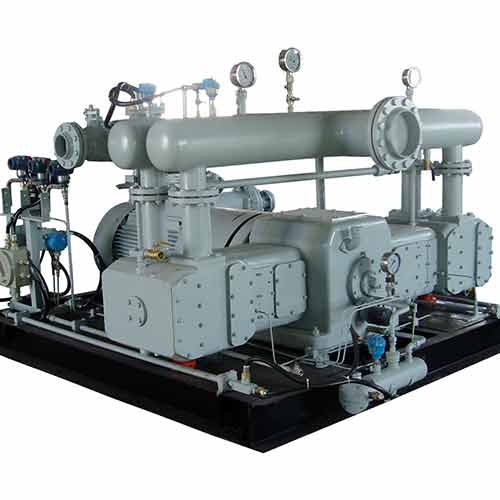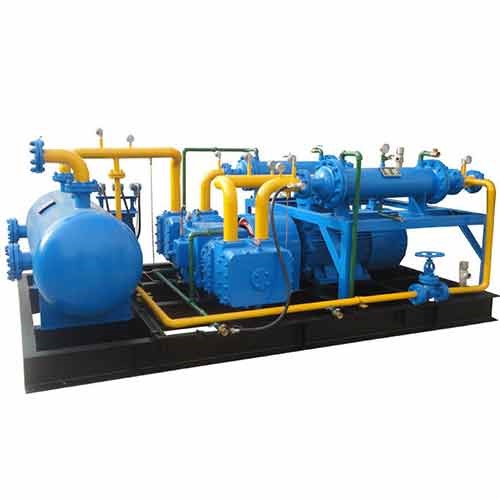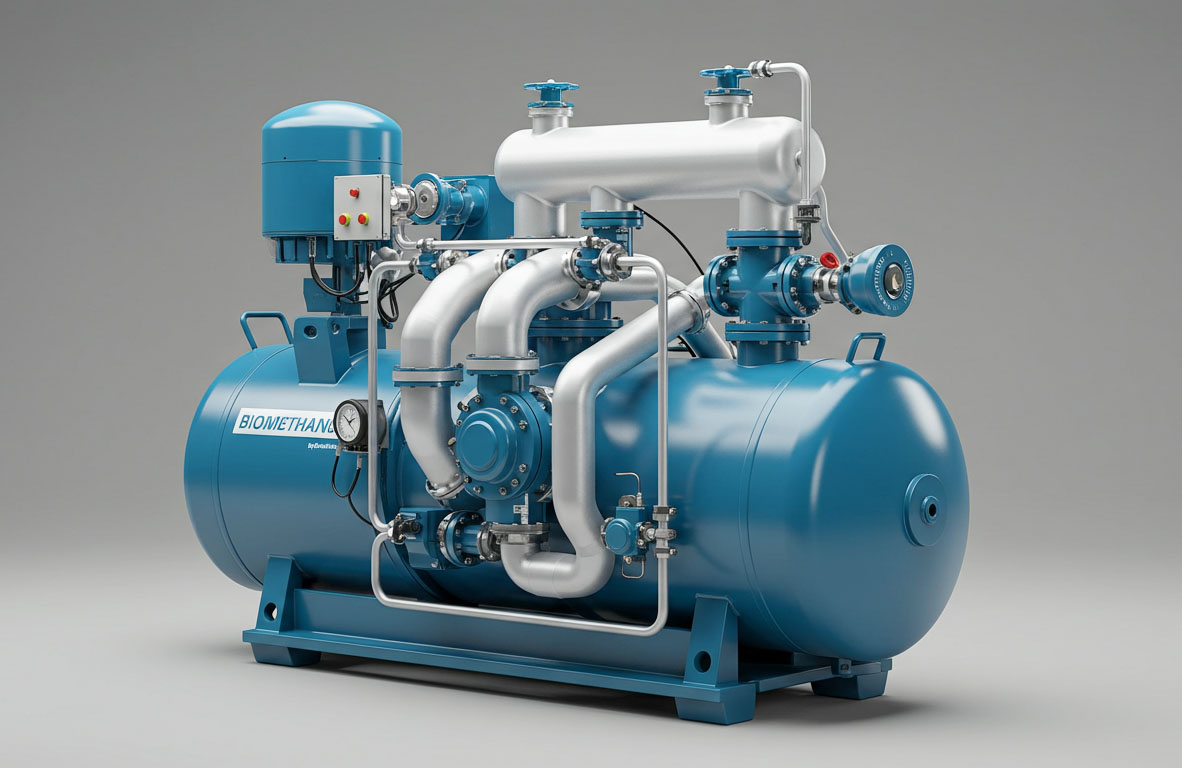Advanced Biomethane Compressor: Paving the Way for Sustainable Energy Solutions
The biomethane compressor plays a pivotal role in harnessing renewable natural gas sourced from organic materials. Its importance is underscored by its efficient compression of biomethane, crucial for its storage and transportation. In our quest for cleaner energy solutions, biomethane emerges as a promising tool in combating greenhouse gas emissions. However, to fully unlock its potential, addressing the pressing requirement for effective storage and transportation methods becomes imperative.
Biomethane: A Quick Recap
What is Biomethane?
Biomethane, or renewable natural gas, represents a sustainable energy source sourced from organic materials like agricultural waste, sewage, and food scraps, obtained through processes such as anaerobic digestion or biogas upgrading.
Advantages
Its significance encompasses several critical dimensions:
- Environmental Advantages: Biomethane stands as a low-carbon energy option capable of substantially curbing greenhouse gas emissions, thereby contributing to climate change mitigation.
- Renewable and Plentiful: It qualifies as a renewable resource because the organic inputs it derives from are consistently replenished, ensuring a dependable, long-term energy solution.
- Enhanced Energy Security: Biomethane diminishes reliance on fossil fuels, bolstering energy security and diversifying the energy portfolio.
- Effective Waste Management: It aids in the effective handling of organic waste, transforming what could be a liability into a valuable and resourceful asset.
The Role of Compression in the Biomethane Chain
Importance of Compressing Biomethane
Originating from organic matter, biomethane presents a green energy solution. To optimize storage and conveyance, it’s essential to compress this gas. Through compression, the volume of biomethane shrinks, making its storage and distribution more cost-effective.
The Science Behind Gas Compression
From a scientific perspective, compressing gas causes its molecules to cluster tightly, occupying less space. This process allows for increased amounts of gas to be stored within limited volumes, enhancing infrastructure efficiency and reducing transport expenses. Hence, compression plays an indispensable role in amplifying the benefits and economic feasibility of biomethane as a renewable energy resource.
Technological Insights: Advanced Biomethane Compressor
Basic Components and Their Functions
Biomethane compression systems primarily consist of compressors, coolers, pressure regulators, and storage tanks. Compressors increase the gas pressure, reducing its volume. Coolers maintain the gas temperature post-compression, ensuring safety and efficiency. Pressure regulators control and stabilize the gas pressure, while storage tanks hold the compressed biomethane.
Innovations and Advancements
Modern compression technologies have embraced innovations like variable speed drives for optimizing compressor efficiency, advanced materials for wear resistance, and smart monitoring systems for predictive maintenance. These developments not only enhance performance but also prolong equipment lifespan.
Efficiency and Energy Consumption Concerns
Efficient compression is vital to ensure that the energy spent on compressing biomethane doesn’t negate its environmental benefits. As such, energy-efficient designs and practices are at the forefront of technological advancements. These include heat recovery systems to reuse compression-generated heat and multi-stage compression processes for optimized energy use. As the biomethane industry grows, the continuous refinement of compression systems to balance energy consumption with efficient output remains a top priority.

Applications and Use-Cases
Transportation Fuel
Compressed Biomethane for Vehicles (CBMV) is emerging as an eco-friendly alternative to traditional fuels. It burns cleaner than diesel or gasoline, reducing greenhouse gas emissions and air pollutants, and making it ideal for buses, trucks, and even cars in regions committed to greener transportation.
Grid Injection
Biomethane, once upgraded to match the quality standards of natural gas, can be injected into existing gas grids. This not only diversifies the energy mix but also capitalizes on established infrastructure, ensuring a reliable energy source that’s both sustainable and compatible with conventional gas utilities.
Energy Storage
As the shift towards renewable energies intensifies, the need for effective energy storage solutions grows. Biomethane holds promise in this domain. By converting excess renewable electricity to biomethane (through processes like electrolysis), it can be stored for extended periods and reconverted to electricity when demand peaks, serving as a long-term, green energy storage medium.
Environmental Impact and Benefits
Reduction in Greenhouse Gas Emissions
Biomethane, when used as an energy source, emits fewer greenhouse gases compared to fossil fuels. Furthermore, its production process captures methane—a potent greenhouse gas—from waste sources, preventing it from entering the atmosphere.
Role in Mitigating Climate Change
Biomethane plays a pivotal role in the global strategy to combat climate change. By replacing fossil fuels in transportation, heating, and electricity generation, it aids in reducing our carbon footprint and slowing global warming.
Economic Advantages
Beyond environmental gains, the biomethane industry stimulates economies. As this sector grows, it creates jobs in production, transportation, and research. Additionally, local economies benefit as waste sources, often viewed as liabilities (like agricultural waste), transform into valuable energy resources. This promotes sustainable economic growth while supporting a greener future.
Future Perspectives
Potential for Technological Advancements
The biomethane industry is ripe for innovation. With ongoing research, we can anticipate improvements in compression technologies, more efficient upgrading processes, and novel applications. These advancements will enhance efficiency, reduce costs, and widen biomethane’s utility.
Expanding Markets and Global Adoption Prospects
As nations prioritize sustainable energy and commit to carbon neutrality, the demand for biomethane is set to surge. Emerging economies, recognizing both the environmental and economic benefits, are increasingly investing in biomethane infrastructure. Moreover, as global consensus strengthens around combating climate change, cross-border collaborations and trade agreements will further bolster biomethane’s adoption, making it a central player in the global energy matrix.
CONCLUSION
Advanced Biomethane Compressor stand at the nexus of technological innovation and environmental responsibility. As global energy needs continue to grow, the push for cleaner, sustainable solutions becomes paramount. Biomethane, with its dual advantages of reducing greenhouse emissions and repurposing organic waste, offers a compelling answer. The advancements in compression technology not only enhance its utility but also bolster its economic viability. With an eye on the future, it’s evident that these systems, through continuous refinement and wider adoption, are charting a course for a greener, more sustainable energy landscape. They represent not just a response to our current challenges but a proactive step towards a brighter, cleaner future.


